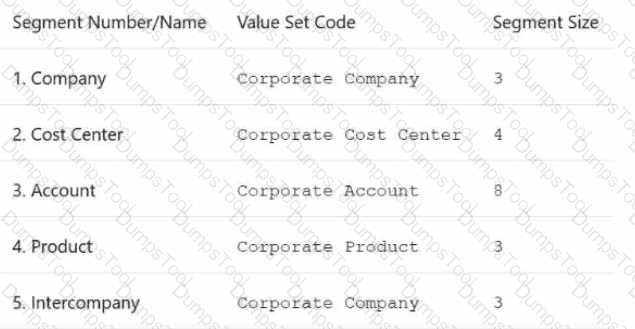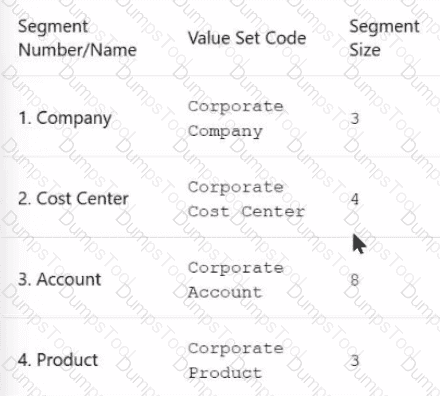After user acceptance testing of the new Oracle Fusion Cloud system, the company's accountants report that they want to be notified of anomalies in certain account balances in real time. The anomalies should include an increase or decrease that is above or below a percentage amount threshold.
What is the best way to meet this requirement?
Your ledger currency is USD. At month end, you have a balance on the Accounts Payable Liability Account of 100,000 Euros, which is equivalent to 136,550 USD. This balance needs to be revalued. The month-end exchange rate for revaluation is 1 Euro = 1.3755 USD.
What two statements are true about the resulting revaluation run?
Manage Chart of Accounts Structure and Instance
Scenario
Your client is implementing Oracle Fusion Cloud Financials. The decision is to have a 5-segment Chart of Accounts: Company, Cost Center, Account, Product, and Intercompany. You are working in
the General Ledger team and will be responsible for creating the Chart of Accounts Structure and Instance for the Chart of Accounts.
Task 1
Create a Chart of Accounts Structure and Instance for the following Chart of Accounts:

Note:
· Prefix all your setups with 07, where 07 is your candidate ID
· There is one balancing segment.
· Choose the appropriate segment labels.
. For the purpose of this test there is no need to deploy the flexfield.
. Valid code combinations should be added to the Code Combination table automatically.
· Shorthand aliases will not be implemented.
. Accept the defaults for the instance segments.
Task 3
Manage Chart of Accounts Mappings
Scenario
Your client needs to consolidate their UK Ledger to the Canadian parent ledger. Each Chart of Accounts
has the following segments:
Company-LoB-Account-Cost Center-Product-Intercompany
Know that the Company, LoB, Product, and Intercompany segments share the same value sets.
Create a Chart of Accounts mappings to map UK Chart of Accounts to CA Chart of Accounts that meets the following specifications:
Cost Center Mapping
. Balance Sheet (0 and 000) should be mapped to
Balance Sheet
. All other cost centers should be mapped to 610
Account Mapping
. Asset accounts (in the 1000 range) should be
mapped to account 11101
. Liability accounts (in the 2000 range) should be
mapped to account 22100
. Equity accounts (in the 3000 range) should be
mapped to account 34000
. Revenue accounts (in the 4000 range) should be
mapped to account 42000
. Expense accounts (from 5000 onwards) should be
mapped to account 51100
Note:
· Do not use conditions based on parents.
. Treat any account after the 5000 range as an expense.
· Ensure all maps are numeric only.
· When creating your mapping rules for each segment
please allow for existing and future segment values
Challenge 2
Manage Shorthand Aliases
Scenario
Your client intends to utilize the Shorthand Alias feature and would like to see how the aliases will appear when entering transactions.
Task 2
Create a shorthand alias for the US Chart of Accounts to record Revenue Domestic for Supremo Fitness, Line of Business 2, and US Operations Cost Center.

Note:
. Prefix your alias name with 07, where 07 is
your exam ID.
. There is no Product or Intercompany
impact.
You define intercompany balancing rules that are applied to a specific source and category, such as Payables and Invoices, or a specific intercompany transaction type, such as Intercompany Sales.
Which statement on intercompany configuration is true?
You need to define a chart of accounts that includes an intercompany segment. Your customer plans to use segment value security rules for the Company segment.
What is Oracle's recommended method to define this chart of accounts?
Your company hascomplex consolidation requirementswithmultiple general ledger instances. You are usingOracle Hyperion Financial Managementto consolidate the disparateGeneral Ledgers.
You can typically map segments between yourgeneral ledger segmentto aHyperion Financial Management segment, such as:
Company to Entity
Department to Department
Account to Account
What happens to segments in yoursource general ledger, such asProgram, thatcannot be mappedtoHyperion Financial Management?
There is a business requirement for a subsidiary company to report to the parent company on a monthly basis.
Given that:
The subsidiary is in another country from the parent.
There is no requirement to have daily balances.
The objective is to minimize the data stored in the reporting currency.
Which data conversion level should you recommend?
Your Oracle Fusion Cloud client needs to store balances such as floor space, number of employees, quantities purchased for use in journal allocations, and financial reporting.
Currently, in their test environment, they are unable to record statistical amounts.
What is the reason?
You entered users who are bothemployees and contingent workers. You want an automated way toassign, reassign, and remove rolesfrom users. What feature do you use?
The Cloud Client wants to add a global branding logo and more predefined transactional attributes to the journal approval email notification.
Which two Business Intelligence catalog objects should you copy (or customize) and edit? (Choose two.)